

“The city of Zaytun (Quanzhou), magnificent and beautiful… It is one of the largest ports in the world. A great number of merchants have swarmed to this city. Goods pile up like hills. The scene is incredible.” This quote from Marco Polo described Quanzhou’s prosperity hundreds of years earlier. The filming crew of People’s Daily Online set foot on Quanzhou recently, following the path of Marco Polo, to unveil the beauty of this gorgeous city.
Quanzhou, a coastal city located in the southeast of China, is well-known as the starting point of the ancient Maritime Silk Road. From the 10th-14th century, Quanzhou, which was known as Zaytun, was the largest port in the east.
Quanzhou grew to possess international historical significance thanks to its advantageous geographic position and it remains an affluent land after the founding of the People’s Republic of China in 1949.
In the Quanzhou Museum for Overseas Communication History, you can find evidence of China’s relationship with the rest of the world through the ancient Maritime Silk Road, including approximately 160 typical ship models from different periods. It is the first museum to hold a repertoire of historical relics reflecting the prosperity of ancient China’s overseas trade, a perfect place that shows how China started to connect with the rest of the world by sea.
Wang Liming, a researcher at the museum talked about the geographic characteristics of this city, which is a major reason for its blooming economy back in the past.“The ancient people of Quanzhou lived near the sea, so they relied heavily on the sea for a living. They saw the sea as their farmland. That's why foreign trade has never stopped in the course of Quanzhou's development.”
The exchange of goods not only builds up systematic trade networks with the outside world, but also provides a place to nurture vibrant cultures. Nanyin music is one of the symbols that could embody the essence of this city. As one of China's most ancient musical styles, Nanyin is reputed as a “living fossil of Chinese music”, allowing generations today a chance to appreciate the beauty of ancient Chinese art.
Li Baiyan, an inheritor of intangible cultural heritage of Nanyin music, told People’s Daily Online, “Nanyin music is an ancient musical performing art with great charm. With long, elegant and beautiful melodies and a style of classic simplicity.”
Art forms are well preserved here in Quanzhou, but they will never overshadow its natural advantage as a port city, China's early gateway to the world.
Possessing a coastline as long as 541 km, Quanzhou is naturally posed to closely connect itself with the rest of the world, using silk, tea and porcelain during the ancient Silk Road era, and then shoes, clothes and much more in the last 70 years.
Wei Yuede is the ninth generation of his family to be tightly bound with Tieguanyin, a premium variety of Chinese oolong tea that originated in Anxi County of Quanzhou, Fujian Province. In his word, he has devoted all his time into one thing- making Tieguanyin.
He put emphasis on how important it is for a tea master to make a difference in the tea industry, “There can be big differences in skills and techniques for producing tea. The production process of Tieguanyin is very complicated, so if you can handle the production process of Tieguanyin, you can produce any tea.”

Wei Yuede also pointed out how Tieguanyin has changed not only the living condition of his family, but also the whole tea industry and the economic landscape of Anxi County, “Tea has helped develop Anxi County from one of the country’s 100 poorest counties into one of the top 100 counties in terms of comprehensive strength.”
Tea was not the only export that found favor with the rest of the world. So, too, did Chinese porcelain. Su Xianzhong is the fourth generation born in a family well-known for white porcelain, a kind of exquisite white porcelain that was highly praised by European countries, especially France, as “White from China”.
Even though Su’s great-grandfather won a gold medal during the 1915 Panama Pacific International Exposition, he and his family had gone through several ups and downs over the last 120 years.
Su gradually learned to express himself through the porcelain in a way that the world would understand and appreciate, especially after the reform and opening-up 40 years ago, when he and his father were able to start their own private company and focus more on expressing their artistic ideas through porcelain making.
“Dehua County must have universal languages if it wants to promote its overseas engagement,”said Su.
To those unfamiliar with the success of ancient China, Dehua Porcelain may give some insight into how China traded on a global level, both then and today.
Zheng Pengfei is the general manager of a local porcelain factory in Dehua County, a factory that has connections with some of the most famous companies in the world, such as Walmart, Target and Disney.
About 80% of their porcelain products are mass produced and sold to over 100 countries. And for Zheng himself, it means more business opportunities both abroad and at home in China.
Since the People's Republic of China was founded 70 years ago, especially after the Reform and Opening-up policy was initiated 40 years ago, locals in Quanzhou, like Mr. Zheng, have seized opportunities and created their own path of economic success.
Huang Jinhui, is a vendor at Shishi Clothing Market in Quanzhou. According to him, “At the beginning of the 1980s, many places here were hometowns of overseas Chinese. And there were a lot of overseas Chinese doing business here. Later, the place developed into a small commodities market and was regarded as ‘little Hong Kong’”.
Hazim-Alrikabi, a foreign buyer who always flies around China searching for good clothes with reasonable prices, agrees with Huang’s words.
“Now in China, clothing is cheaper, as there are good locations and many factories. China is a vast country. Every province or city of China has companies in the clothing industry, such as Yiwu, Guangdong, Beijing, Shandong, Shanghai, and Shishi. Every place has different clothing,” said Hazim.
In 2018, Quanzhou's GDP amounted to approximately 125 billion dollars, ranking first in Fujian Province. Besides its traditional industries, Quanzhou's high-tech industries contributed a lot to the astonishing development of the city's economy.
Wu Shang is the vice president of a local technology company in Jinjiang of Quanzhou. According to Wu, the production process of umbrellas in the famous umbrella base Dongshi Town is faced with a shortage of labor, and they have provided a solution to the problem. The new equipment they have provided for the umbrella companies only requires one man to operate, while it used to need six workers to make an umbrella.
Hundreds, if not thousands, of years of global communication with the rest of the world have turned Quanzhou into a hub which shows respect for and welcomes different cultures, which have, in turn, paved the way for its rapid development in the last 70 years.

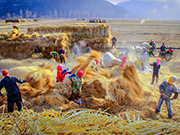 Award-winning photos show poverty reduction achievements in NE China's Jilin province
Award-winning photos show poverty reduction achievements in NE China's Jilin province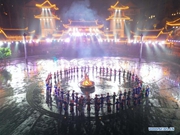 People dance to greet advent of New Year in Ameiqituo Town, Guizhou
People dance to greet advent of New Year in Ameiqituo Town, Guizhou Fire brigade in Shanghai holds group wedding
Fire brigade in Shanghai holds group wedding Tourists enjoy ice sculptures in Datan Town, north China
Tourists enjoy ice sculptures in Datan Town, north China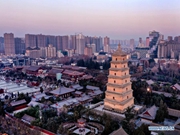 Sunset scenery of Dayan Pagoda in Xi'an
Sunset scenery of Dayan Pagoda in Xi'an Tourists have fun at scenic spot in Nanlong Town, NW China
Tourists have fun at scenic spot in Nanlong Town, NW China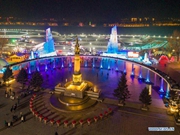 Harbin attracts tourists by making best use of ice in winter
Harbin attracts tourists by making best use of ice in winter In pics: FIS Alpine Ski Women's World Cup Slalom
In pics: FIS Alpine Ski Women's World Cup Slalom Black-necked cranes rest at reservoir in Lhunzhub County, Lhasa
Black-necked cranes rest at reservoir in Lhunzhub County, Lhasa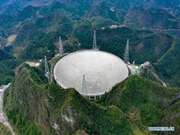 China's FAST telescope will be available to foreign scientists in April
China's FAST telescope will be available to foreign scientists in April